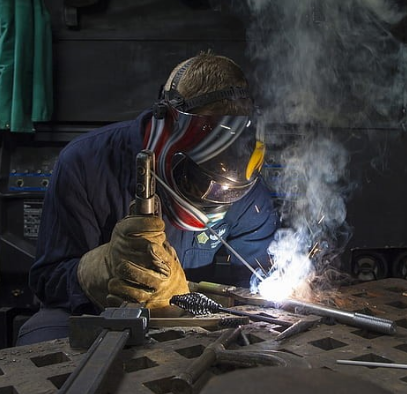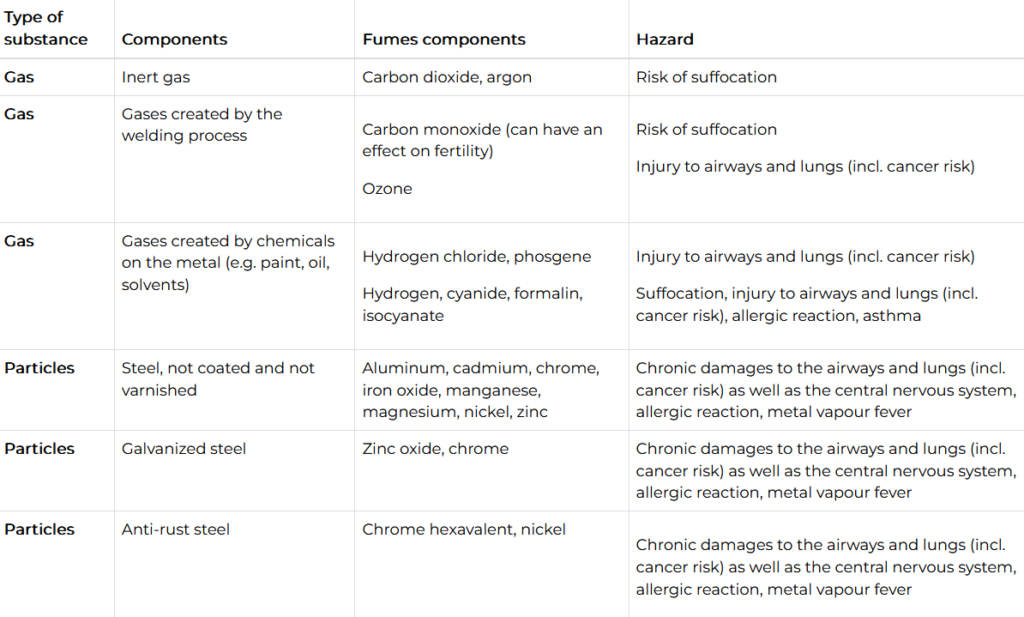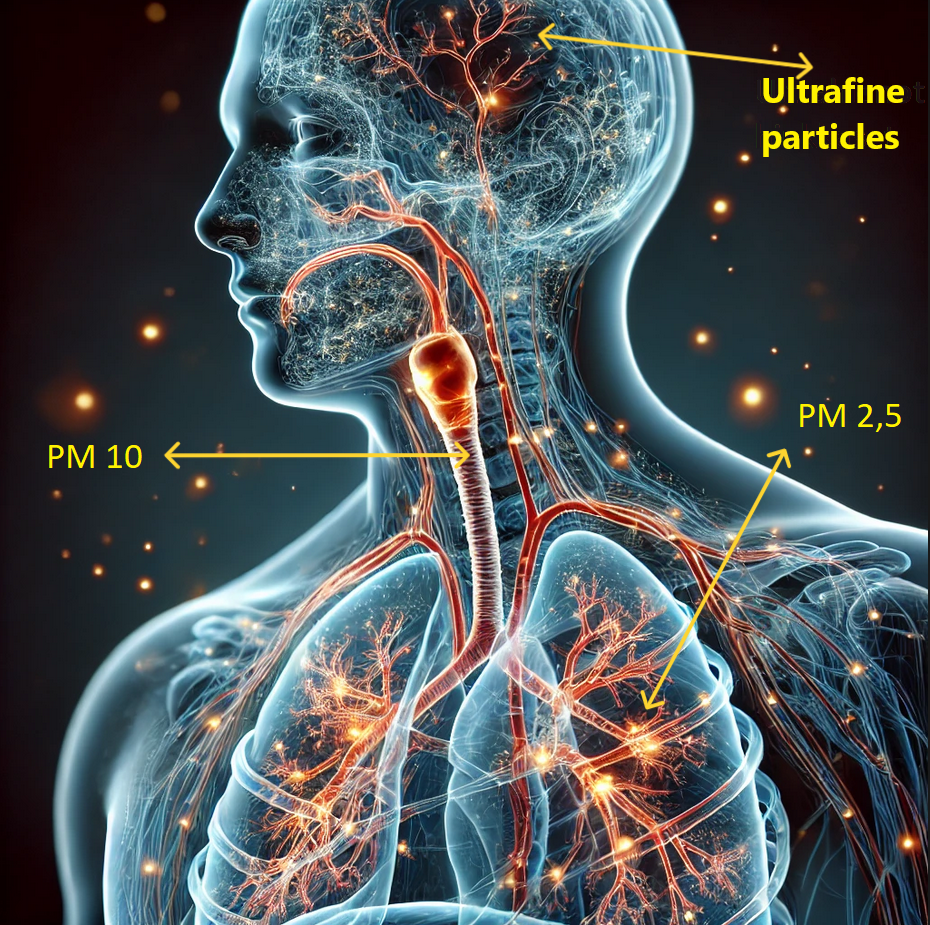Kemper extraction and filtration
“Good to know” – A few words about welding fumes in general
We’ve divided the topic into four parts:
- Welding fumes – What are they?
- The composition of welding fumes.
- The particle size of individual fume components.
- The effects of welding fumes when they enter the human body.
1. Welding fumes – What are they?
In everyday language, they’re called welding smoke or fumes – but let’s look at the issue a bit more theoretically. Metalworking processes, especially welding and cutting, along with related procedures, generate fumes (both gases and vapors) that are classified as hazardous substances under current regulations. Welding fumes pose a health risk and can, in part, even cause cancer or genetic mutations.
For over 40 years, welders have relied on KEMPER’s efficient fume extraction systems. Every KEMPER extraction and filtration unit captures welding fumes with high efficiency and safely filters out even ultra-fine particles from “dirty” air.
The size of welding fume particles challenges our thinking!
Welding fumes consist of a variety of gases and millions of ultra-fine dust particles, or fumes. These particles are on the nanometer scale, smaller than 0.1 µm (1 µm = 0.001 mm), and cannot be seen with the naked eye.
Let’s look at it from a metaphorical point of view:

The size ratio between a nanoparticle and a soccer ball is nearly the same as the size ratio between a soccer ball and the Earth!
What happens if welding fumes are not effectively extracted or filtered?
The contaminants in welding fumes accumulate in the human body, where they cause damage and trigger diseases. This is a long-term process, the consequences of which are unfortunately often noticed far too late. That’s what makes welding fumes so insidious!
2. Composition of Welding Fumes

Particles:
- Lead oxide
- Iron oxides
- Nickel oxide
- Beryllium oxide
- Hexavalent chromium
- Thorium oxide
- Manganese
Gases:
- Phosgene
- Ozone
- Carbon monoxide
- Carbon dioxide
- Nitrogen oxides
- Formaldehyde
- Benzoic acid
The above lists only include the most hazardous components found in welding fumes – in addition to these, many other impurities can occur in welding and cutting processes.
We distinguish between respirable particles (up to 100 µm) and alveolar-penetrating particles (up to 10 µm). These fine particles can reach the alveoli of the lungs and settle there, making them particularly dangerous. In fact, up to 98.9% of the particles in welding fumes are smaller than 0.4 µm.
The composition of welding fumes (gases and particles) depends on the material being welded and the welding process used.
Table:

3. Size of individual particles in welding fumes
Welding fumes consist of many different substances, many of which fall within the nanoparticle size range. But how small are these nanoparticles, really?
Here’s how the size distribution breaks down:
- 1 millimeter = 1,000 micrometers
- 1 micrometer / 1 µm = 1,000 nanometers
To put it metaphorically:
The ratio of a single welding fume particle to a blueberry is the same as the ratio of a blueberry to the entire surface area of Finland.
Particles the size of one micrometer cannot be seen with the naked eye.
This invisibility is exactly what makes these ultra-fine particles so dangerous—they are essentially invisible toxins.
Based on particle size, dust is categorized into separate so-called “partial hazards”:
- Coarse dust refers to particles 10 µm and larger.
- Fine dust includes smaller particles, down to 0.01 µm, which already enters the domain of ultra-fine dust and gas molecules.
But how far can these particles travel inside the human body?

PM 10
- Can enter the nose, mouth, and upper respiratory tract.
- Primarily accumulate in the nose, throat, and bronchi.
- Some may penetrate deeper into the bronchial tubes, but generally do not reach the alveoli.
PM 2.5
- Can pass through the bronchi and reach the alveoli.
- Small enough to be absorbed into the bloodstream from the alveoli.
- Linked to cardiovascular and respiratory diseases.
Ultrafine particles (under 0.1 µm)
- Can pass through the alveoli into the bloodstream.
- May spread throughout the entire body and even reach the brain.
In Finland, occupational exposure limits (HTP values) for air impurities in workplaces are defined by the Ministry of social affairs and health.
Employers are legally required to follow these HTP values to ensure occupational safety and to design safe working environments (Government Decree 2020).
HTP value refers to a concentration known to be harmful. These values are defined and confirmed by the Ministry of Social Affairs and Health under the Occupational Safety and Health Act (738/2002), section 38, paragraph 4, through decree 654/2020.
According to current knowledge, no risk to workers’ health or safety is expected if the concentration of impurities remains below the HTP value.
However, there is no HTP value set in Finland for welding fumes from steels.
The Finnish Institute of Occupational Health (FIOH) has established target levels (i.e., recommendations) that companies can use to aim for better-than-minimum legal standards in workplace air quality.
FIOH has set the target level for welding fumes at 0.1 mg/m³ (FIOH 2011).
A commonly used reference level in many contexts is 1 mg/m³, which is practically and undeniably a very high value. Because welding fumes are extremely harmful, actions to eliminate them should not be delayed or ignored.
This responsibility does not rest solely with company management or owners.
Individual welders also bear responsibility.
If local exhaust systems like fume extraction arms have been installed, workers are obligated to use them—regardless of whether they are seen as inconvenient or whether personal respiratory protection is used.
4. Effects of welding fumes when they enter the human body
The impurities present in welding fumes can be divided into three categories:
- Substances that strain the respiratory tract and lungs
- Toxic and poisonous substances
- Carcinogenic (cancer-causing) substances
1. Substances that strain the respiratory tract and lungs:
Examples:
- Iron oxides
- Aluminum oxides
Prolonged exposure or high concentrations of these substances can overload the respiratory system. This may lead to respiratory illnesses such as (chronic) bronchitis or asthma, and the accumulation of metals in the lungs (e.g., siderosis, aluminosis).
2. Toxic or poisonous substances:
Examples:
- Hydrogen cyanide
- Carbon monoxide / carbon dioxide
- Trivalent chromium compounds
- Manganese oxide
These substances can cause poisoning if a certain threshold is exceeded in the body. Their toxic effects may, for example, inhibit the blood’s ability to carry oxygen. Other symptoms may include:
- Irritation of the mucous membranes and respiratory tract
- Respiratory paralysis or rapid breathing and heart rate
- Headache, fatigue, and dizziness (including fainting)
- Nausea
- Pulmonary edema, which can be fatal
3. Some of these substances are also carcinogenic:
Examples:
- Hexavalent chromium compounds
- Various oxides (e.g., hydrogen cyanide, beryllium oxide, nickel oxide)
Carcinogenic substances can cause malignant tumors. The risk of cancer increases with the dose of exposure. These substances often also have toxic effects.
We encourage you to take a moment to consider the air quality in your own workshop. Is the air you breathe truly safe – even if there’s no visible smoke? Let us help! Together, we can ensure a cleaner and safer working environment.
- Use AirWatch to measure the air quality on-site
- Review the results together and find the right solution for your needs
- Install the appropriate equipment
- Continue monitoring air quality and compare before and after results
What is Kemper AirWatch?
AirWatch takes air samples at regular intervals from the airflow passing through it. Using a laser, it analyzes the air inside and calculates the number and size of particles, dividing them into three particle size categories. The results are then presented in various time-based formats for detailed analysis.
The device can also be configured to control other Kemper systems. When predefined threshold values are exceeded, it can automatically activate equipment—starting, for example, with just one machine. If the air quality continues to deteriorate, additional devices are activated — fully automatically, without the need for manual intervention. Similarly, when particle levels drop, unnecessary use of filtration systems is reduced — AirWatch manages them intelligently.
AirWatch also helps identify the optimal placement of extraction and filtration units within the workspace, ensuring maximum efficiency.

